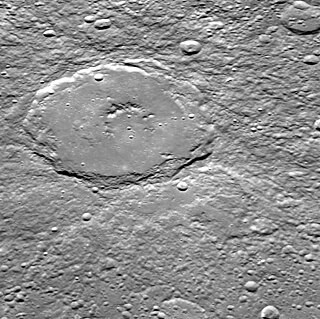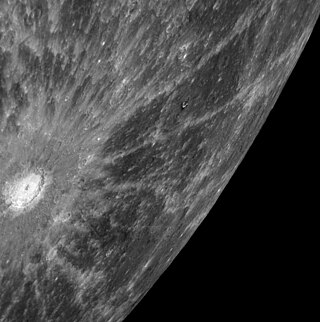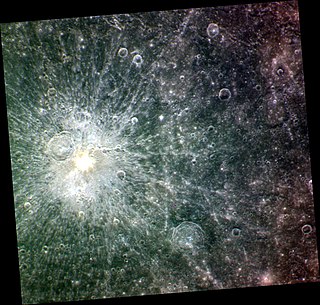
Tir Planitia is a large plain on the planet Mercury. The name Tir (تیر) is the Persian word for "Mercury",, and the name was approved in 1976. It was first observed in detail by Mariner 10. It lies between the large crater Mozart and the ancient Tolstoj basin.

Kuiper is a moderate-size crater with a central peak cluster located at 11.35°S 31.23°W on Mercury. It is 62 kilometers in diameter and was named after Dutch-American astronomer Gerard Kuiper in 1976. It is one of only 2 Mercurian craters which are named not after artists, and one of very few cases when the same name is used for 3 craters. Gerard Kuiper, being a leader of American planetary science, died shortly before the first images of Mercurian surface were made.

Matisse is an impact crater on the southern hemisphere of Mercury. Matisse takes its name from the French artist Henri Matisse, and it was named by the IAU in 1976.

Mozart is a crater on Mercury, named by the IAU in 1976 after Austrian composer Wolfgang Amadeus Mozart.

Xiao Zhao crater is small in comparison with many other craters on Mercury. However, Xiao Zhao's long bright rays make it a readily visible feature. The fresh, bright rays, which were created by material ejected outward during the impact event that formed the crater, indicate that Xiao Zhao is a relatively young crater on Mercury's surface.

Verdi is an impact crater on the planet Mercury. It was named after Italian Romantic composer Giuseppe Verdi (1813–1901) in 1979, as recognized by the International Astronomical Union. The crater's extensive ejecta blanket and secondary crater field are superposed on plains materials and older craters.

Stravinsky is a crater on Mercury. It overlays the rim of the much older Vyāsa crater. It was named by the IAU in 1979 for the influential Russian composer Igor Stravinsky.

Praxiteles is a crater on Mercury. It is one of 110 peak ring basins on Mercury.

Moody is an impact crater on Mercury.

Hovnatanian is a crater on Mercury. Its “butterfly” pattern of ejecta rays were created by an impact at an even lower angle than that which formed neighboring Qi Baishi crater. From the "butterfly" pattern of rays, the Hovnatanian impactor was travelling either north-to-south or south-to-north prior to hitting Mercury's surface. Hovnatanian lies to the west of Tir Planitia.

Berkel is a crater on the planet Mercury. Its name was approved by the IAU on July 9, 2009. It was named after the modernist painter Sabri Berkel.

Debussy is a rayed impact crater on Mercury, which was discovered in 1969 by low resolution ground-based radar observations obtained by the Goldstone Observatory. Later in 1990–2005 it was imaged in more detail by the Arecibo Observatory. The crater was initially known as the feature A. The bright appearance of rays in the radar images indicates that the crater is geologically young, because fresh and rough surfaces of young impact craters are good scatterers of radio waves.

Raden Saleh is a crater on Mercury. Its name was approved by the IAU in 2008, and it is named after a famous Indonesian painter named Raden Saleh.

The Hovnatanyan family was a prominent Armenian family of painters. They include five generations from 17th to 19th centuries. Hovnatanyans are originally from the village of Shorot, Yernjak district in Nakhichevan.

Bartók is a crater on Mercury. Its name was adopted by the International Astronomical Union (IAU) in 1979. Bartók is named for the Hungarian composer Béla Bartók, who lived from 1881 to 1945.

Darío is a crater on Mercury. It has a diameter of 151 kilometers. Its name was adopted by the International Astronomical Union (IAU) in 1976. Dario is named for the Nicaraguan poet Rubén Darío, who lived from 1867 to 1916.

Geddes is a crater on Mercury. It has a diameter of 84 kilometers. Its name was adopted by the International Astronomical Union (IAU) in 2010. Geddes is named for the Irish stained glass artist Wilhelmina Geddes, who lived from 1887 to 1955.

Jókai is a crater on Mercury. Its name was adopted by the International Astronomical Union (IAU) in 1979. Jokai is named for the Hungarian novelist Mór Jókai, who lived from 1825 to 1904.

Caravaggio is a large crater on Mercury. The crater was named after the Italian painter Caravaggio by the IAU in 2013.

Nureyev is a crater on Mercury. It has a diameter of 16 kilometers, and has a bright and extensive ray system. Its name was adopted by the International Astronomical Union (IAU) on April 24, 2012. Nureyev is named for the Soviet and British ballet dancer Rudolf Nureyev.





















